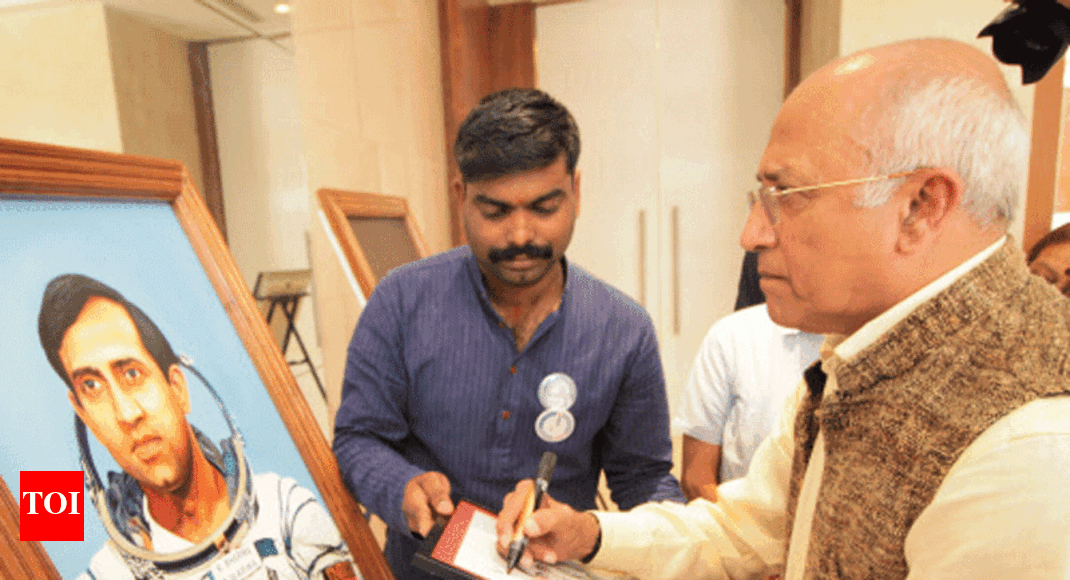The Life And Times Of Rakesh Sharma: India's Pioneer In Space

Table of Contents
Early Life and Education of Rakesh Sharma
Family Background and Childhood
Rakesh Sharma's early life laid the foundation for his future achievements. Born on January 13, 1949, in Patiala, Punjab, his upbringing likely instilled in him the values of discipline and perseverance that would later prove crucial in his demanding career. While detailed information about his childhood is scarce in the public domain, we can infer that his inherent curiosity and aptitude for science and aviation played a significant role in shaping his path.
Academic Journey
Sharma's academic excellence paved the way for his selection as an astronaut. He pursued a degree in engineering, demonstrating a strong analytical mind and a passion for technology. His journey continued with his enlistment in the prestigious Indian Air Force, where he honed his skills as a highly accomplished test pilot. This demanding role required exceptional precision, courage, and a deep understanding of aviation technology—all essential traits for an astronaut.
- Education: National Defence Academy, Khadakwasla, followed by the Indian Air Force Academy.
- Significant Accomplishments: Distinguished service in the Indian Air Force, achieving the rank of Wing Commander, demonstrating exceptional piloting skills and technical expertise.
- Early Interest: A childhood fascination with flight and space exploration propelled him toward a career in aviation and eventually, into the stars.
Selection and Training for the Space Mission
The Selection Process
The selection of Rakesh Sharma for the Indo-Soviet space mission was a rigorous process. The Indian Space Research Organisation (ISRO), in collaboration with the Soviet Union, established stringent selection criteria. Candidates were rigorously assessed for their physical and mental fitness, technical proficiency, and psychological resilience. Sharma's exceptional background as a test pilot and his unwavering dedication made him a standout candidate among a pool of highly qualified individuals.
Rigorous Training Regimen
Following his selection, Rakesh Sharma embarked on an intense training regimen, encompassing both Indian and Soviet facilities. The training involved a comprehensive curriculum designed to prepare him for the unique challenges of space travel. His preparation included extensive simulations of spaceflight conditions, rigorous physical conditioning to withstand the gravitational forces of launch and re-entry, and survival training for various emergency scenarios. He underwent specialized cosmonaut training at the Yuri Gagarin Cosmonaut Training Center in Star City, Russia, mastering the intricacies of the Soyuz spacecraft.
- Training Locations: India and the Yuri Gagarin Cosmonaut Training Center, Star City, USSR.
- Training Types: Flight simulations, centrifuge training (to simulate high G-forces), zero-gravity simulations, survival training, and extensive study of the Soyuz spacecraft systems.
- Training Duration: Years of intensive preparation, culminating in the readiness for the mission.
The Historic Soyuz T-11 Mission
Launch and Journey to Space
On April 3, 1984, Rakesh Sharma's dream took flight. He launched aboard the Soyuz T-11 spacecraft alongside Soviet cosmonauts Yuri Malyshev and Gennady Strekalov. Their mission was to dock with the Salyut 7 space station, a pivotal event in the history of Indo-Soviet space cooperation. The successful launch and docking marked a significant milestone for India, showcasing its growing capabilities in space exploration.
Experiences in Space
Aboard the Salyut 7 space station, Rakesh Sharma conducted various scientific experiments, contributing to the understanding of microgravity's effects on biological and physical processes. His observations of Earth from space provided valuable data for various scientific and geographical studies. Beyond the scientific aspects, Sharma's experience of weightlessness, the breathtaking view of Earth, and the challenges of daily life in space provided a unique and profoundly enriching experience. He famously responded to Prime Minister Indira Gandhi's inquiry about his view of India from space with the iconic words, "Sare Jahan Se Achcha," ("Better than the whole world").
- Mission Duration: Approximately eight days.
- Key Scientific Experiments: Experiments related to materials science, biology, and Earth observation.
- Reaction to Space: Sharma's experiences highlight the awe-inspiring nature of space travel and its profound impact on the human perspective.
Legacy and Impact of Rakesh Sharma's Mission
National Pride and Inspiration
Rakesh Sharma's mission instilled immense national pride in India. He became a national hero, embodying courage, determination, and scientific excellence. His achievement inspired countless young Indians to pursue careers in science, engineering, and space exploration, significantly influencing the growth and development of the Indian space program. He remains a role model for aspiring scientists and engineers across the nation.
Advancements in Space Technology
The Indo-Soviet cooperation, exemplified by Rakesh Sharma's mission, led to significant advancements in Indian space technology. The mission provided valuable experience and expertise, contributing to ISRO's subsequent successes. It fostered technology transfer and knowledge sharing, laying the foundation for future collaborations in space exploration. This collaborative spirit also helped to shape India’s independent space endeavors in the years that followed.
- Specific Advancements: The mission enhanced India's capabilities in satellite technology, remote sensing, and space-based research.
- Long-Term Effects: It spurred increased investment in education and research related to space science and technology.
- Awards and Recognitions: He received numerous awards and recognitions for his contributions, including the Ashoka Chakra.
Conclusion: Celebrating the Enduring Legacy of Rakesh Sharma
Rakesh Sharma's journey into space represents a landmark achievement in Indian history, cementing his place as a pioneer of space exploration. His mission on Soyuz T-11 not only propelled India into the global space arena but also ignited a passion for science and space research within the nation. The enduring legacy of Rakesh Sharma serves as an inspiration, motivating future generations to reach for the stars. To learn more about Rakesh Sharma's journey and the history of India's space program, explore the resources available online. Discover more about India's first astronaut, Rakesh Sharma, and his remarkable contribution to the nation’s pursuit of space exploration.

Featured Posts
-
 Chinas Steel Production Cuts Impact On Iron Ore Prices And Global Markets
May 09, 2025
Chinas Steel Production Cuts Impact On Iron Ore Prices And Global Markets
May 09, 2025 -
 Broadcoms Extreme Price Hike On V Mware At And T Faces 1 050 Cost Increase
May 09, 2025
Broadcoms Extreme Price Hike On V Mware At And T Faces 1 050 Cost Increase
May 09, 2025 -
 Stivn King Na Netflix Ochakvaniyat Rimeyk
May 09, 2025
Stivn King Na Netflix Ochakvaniyat Rimeyk
May 09, 2025 -
 Ecologistes Aux Municipales 2026 Leurs Ambitions Pour Dijon
May 09, 2025
Ecologistes Aux Municipales 2026 Leurs Ambitions Pour Dijon
May 09, 2025 -
 New Dna Evidence Could This 23 Year Old Woman Be Madeleine Mc Cann
May 09, 2025
New Dna Evidence Could This 23 Year Old Woman Be Madeleine Mc Cann
May 09, 2025
